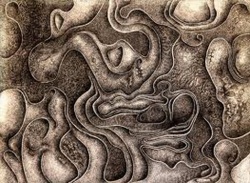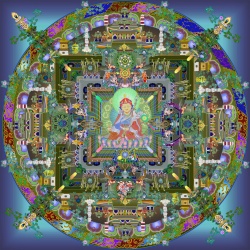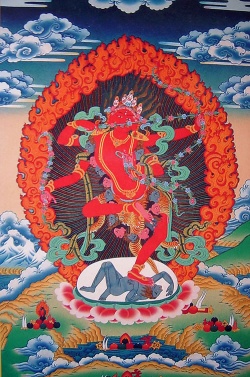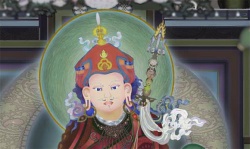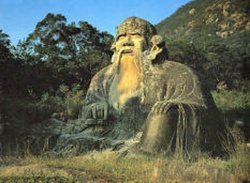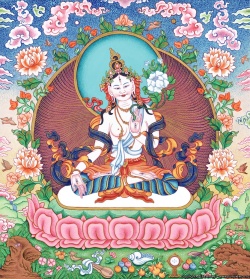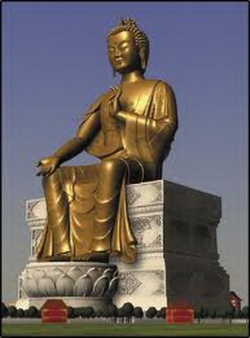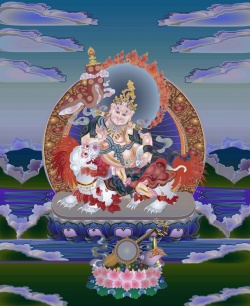Buddhist Meditation By G. J. Yorke
By G. J. Yorke
Studies in Comparative Religion, Vol. 2, No. 3. (Summer, 1968) © World Wisdom, Inc.
www.studiesincomparativereligion.com
SOME two thousand, five hundred years ago Siddartha, the eldest son of the elected head of the Sakya clan, left his wife and child to become a wandering naked ascetic. After some five years, during which he mastered the techniques of yoga under at least two qualified teachers, he found that yogic asceticism and the trance states to which it leads were not the answer that he was seeking. So he decided to wear clothes once more and if possible to eat one good meal a day. When he had recovered his health, he developed his own system of meditation and about a year later sat down under a tree and vowed not to leave its shade until he was enlightened.
It seems that he sat under that tree reviewing his life and all that he had been taught and had experienced. Then he entered within himself and passed through the various states of trance or absorption, starting with those with form and then refining them into the formless and inexpressible. In them he was still unenlightened. Suddenly he came out of a trance and saw the morning star. At this conscious act he realised that he had succeeded at last.
After many lives of service and spiritual struggle and a final six years of dedicated meditation he was the Buddha, the Enlightened or Awakened One. As he put it: "When I fully understood as it really is, the satisfaction in the world as such, the misery in the world as such, and the escape therefrom as such, then did I understand the meaning of being enlightened in the world.
Then did knowledge and insight arise in me..." Some seven months later he preached his first sermon in a deer park and by so doing began to turn the Wheel of the Dharma. He was thirty-five years old at the time. In other words enlightenment is a practical down to earth experience within the theoretical reach of each one of us while we are still human beings. It is achieved by transforming the knowledge and insight that we each have at the moment into the knowledge and insight of a Buddha, of a fully enlightened human being. The simplest and quickest way to do this is to do what the Buddha did and then taught for some forty years.
Before, however, detailing what should be done, something must be said about Bodhi or Enlightenment. It is an attitude of body, heart and mind that has to be experienced and expressed here in this world by a man's own efforts in this or some future life. Therav?din Buddhists, unlike Christians, have no Saviour to help them. For them there is no salvation by Grace and no direct assistance from any source outside this world. Moreover the knowledge and insight which lead to Enlightenment cannot be developed in any of the Buddhist heavens or hells. In them one is totally involved in the joy or misery of the experience.
Moreover they are not eternal, so that after suffering or enjoying the period of time that one has earned in them, one may return to this world to try again. That is why a Buddhist gives thanks for his good fortune in having been born a human being, since only as such can the knowledge and insight of an enlightened man or woman arise in him or her. Buddhism starts with a fact which everyone accepts and a statement which is a question of faith until personal experience proves it true for oneself. The fact is simple, for it is oneself as one perceives, feels and thinks at the moment.
The statement which is a question of faith until experienced is that there is what the Buddha called the Not Born, the Not Become, the Uncreated, the Unconditioned and about which he declined to go into details because they are unknowable. In Mah?y?na Buddhism this is called the Buddha nature or the essence of heart and mind. It is not what Christians mean by the soul, as there is nothing personal about it. As soon as we experience it, it ceases to be a matter of faith. We are all slaves to our present way of thinking, to our desires, to the habits and tendencies that we have inherited in varying degrees from our previous lives and which we have developed by reacting to our environment.
As a result we are obsessed by desire, dislike and delusion. This habitual attitude works within the framework of time, space and causation, and what develops is equally temporary, namely personal consciousness. It discriminates between self and others, subject and object, and so on. What I think that I am now has to be integrated with the Unconditioned, the Buddha nature, the essence of mind and heart. In the process I come to realise that my personal ego is a delusion while I still retain my humanity.
The attitude that has to be changed is that which we have towards ourselves and the world at the moment, for until this happens, until we are enlightened, we and the world will remain in a mess. There are four ways of acquiring the special way of looking at life and living it that is called Enlightenment in Buddhism. They are by working without lust of result, by devotion, by knowledge or wisdom acquired through learning, and by insight developed through meditation. To start with you choose the method you prefer, for it may well prove the one best suited to your temperament.
But if you do not practise the other three ways as well, you will probably come to grief, for you will be unbalanced. If you study the lives of the Enlightened Ones whether Christian, Hindu, Moslem or Buddhist, you will find that they followed at some time or other each of the four paths of works, devotion, knowledge and insight, and so became integrated. Buddhism, however, insists that meditation be stressed since it develops the vital insight. Now meditation is not a panacea, a cure for all ills. It consists of a great many different techniques or practices which have developed down the centuries to suit the different needs of given individuals.
Each type can kill or cure in accordance with how it is used. A meditational practice can be compared to a dynamo the current from which can kill a pig or charge a battery. Almost anyone who meditates often enough in the right way will find himself at times filled with a nervous energy or life force which, instead of killing the illusory pig that is his personal ego, has merely charged it like a battery. Before he knows where he is, he has become a Dharma-mongerer, an un-enlightened writer on Buddhist meditation, who runs the risk of having to serve time in the Avici hell. Worse still, he may well find that he is so shut up in his private shell that he is in danger of losing his humanity.
The whole thing has turned sour without his realising it, while he revels in his improved vitality, health and powers of concentration. To avoid all this one has to develop a basic attitude to life that is seldom mentioned in Buddhist texts dealing with meditation, since it is taken for granted. This attitude is the key to healthy meditation and to what Christians call a spiritual life. It involves developing faith in something other than one's present self. Another ingredient is compassion, the ability to accept others on their own terms, to understand and by so doing to help them. It means being able to give thanks for every little thing and above all to express gratitude for having been born a human being with a chance to develop in this life the knowledge and insight of a Buddha. Humility is also essential. The development of these qualities when combined with meditation is the first step towards the complete self-surrender without which Enlightenment is impossible.
In all religions down the ages experience has shown that ritual helps to nurse this basic attitude, the increased lack of which is a symptom that we are living in what Buddhists call this Dharma-ending age. It is catered for in monastic life, but those who are living in the world have to find it for themselves through ritual. A short, all inclusive Buddhist one is at hand for our use. The first step in Buddhists, indeed no-one is a Buddhist until he has taken it, is to take refuge in the Triple Gem, in the Buddha or Enlightened One, in the Dharma or Teaching and in the Sangha or Community. So repeat in Pali the traditional formula first thing in the morning and last thing at night, whether or not you follow it up with a daily period of meditation. The words are: Namo tassa bhagavato arahato samm? sambuddhasa—Homage to the Blessed One, the Venerable One, the Supremely Self-Enlightened Buddha.
You make a full prostration and continue:
Buddham saranam gacchami—I go for refuge to the Buddha.
Dhammam saranam gacchami—I go for refuge to the Dharma.
Sangham saranam gacchami—I go for refuge to the Sangha.
All this is then repeated twice more.
Remember that you cannot take refuge in the Buddha in the same way that Christians take refuge in Christ. For Buddha is not a Saviour who can help you and remit your sins. Buddha's is not a breast on which you can lay your head, nor is his lotus seat the rock of ages cleft for you. You go for refuge to the Buddha as the personification of Enlightenment, of Bodhi. This protecting refuge is there within us and around us, but we have to go to it by our own effort. It will not come by itself, nor will it be given. We have to make a conscious act of will and determination directed towards the goal of liberation while on earth.
The hard low Buddhist bed is not for dying on, but for perfecting awareness while alive. The Dharma of the second refuge is not the faint fragmentary and distorted picture of the Teaching that the ordinary layman has. It is the framework within which Buddhist meditation and way of life are set. It consists in learning about all the Dharma-doors which lead to the extinction of suffering and to the freedom of Enlightenment. The Sangha of the third refuge is not the congregation of monks with all the weaknesses of its individual members and with the shortcomings attached to any human institution. It is the fraternity of holy disciples, not necessarily monks or nuns, who are united by common attainment to the four stages of Buddhist sanctity. It is the assurance of the possibility of becoming enlightened here in this or some future life.
This going to or taking refuge in the Triple Gem involves four things: the total surrender of the self, the acceptance of the Gem as one's guiding ideal, the acceptance of discipleship, and giving homage by prostration. Homage represents the emotional side of taking refuge as an act of faith. If given humbly from the heart it prepares the way emotionally for that complete self-surrender without which Enlightenment is impossible. So learn to prostrate properly.
The acceptance of discipleship represents the rational side of taking refuge, for life becomes an act of learning, of adapting the mind to the standards of the Buddha, the Dharma and the Sangha. It supplies the full and satisfying reasons for the act of homage and so adds to the strength and loyalty of devotion. In accepting the Triple Gem as one's guiding ideal, one pledges oneself to give all one's strength to the task of impressing the threefold seal upon one's personal life and environment. The threefold refuge in its aspect of guiding ideal calls for complete dedication in the sphere of external activities.
But this dedication to the service of the Triple Gem through work and activity in the world is still not the highest form of taking refuge. One is still distinguishing between the noble objective and oneself as working for it. The delusive ego is still there, rejoicing in the success of the work, or grieving when it fails. In that partial identification of oneself with one's work, the delusive ego slips into or behind that work and evades the full call to surrender. Further progress is only possible if one's service to the guiding ideal is completely detached and performed without lust of result.
This detached attitude towards all that a man does is one of the many fruits of complete self-surrender to the Triple Gem. Though this surrender is only that of a delusion, it is the hardest sacrifice of which we know. But until it has been made, Enlightenment remains a dream. This ritual of taking refuge at the start and finish of the day, or before each period of meditation, ensures that the latter is squarely within the Buddhist framework so that one is following the path that the Buddha trod. When done properly it will change your whole attitude to life. It takes a long time before one can do it mindfully and from the heart.
Then once a day a few minutes should be devoted to the metta or compassionate meditation. This does not mean sending out waves of thought towards anything or anybody, but developing in the heart feelings of loving kindness to oneself, one's best friend, one's worst enemy, to a person to whom one is neutral and finally to all sentient beings. But a meditational teacher should be consulted before it is done for the first time. A short daily ritual of this type keeps the practiser within the Buddhist framework while developing and retaining that basic attitude to life without which meditation turns sour and Enlightenment is impossible. The next thing to remember is the necessity for a meditational teacher who has been trained properly in the basic traditional Buddhist techniques.
He need not be a bhikkhu and he will not be enlightened, but he must belong to an established school of Buddhism and have behind him a known line of meditational teachers in that school. In other words he must be a professional. This is only common sense. Anyone who takes up a sport without having lessons from a professional soon develops bad habits which become extremely hard to correct. And so it is with meditation. You need guidance on how to deal with your body, heart and mind.
You need special guidance as soon as you enter the psychic world of vision, or you will take your first highly emotional reaction to that world as basic to it, instead of as an illusion about it. Those who do so are as lost as the average hippy who after a trip on LSD talks vaguely about love, It or turpentine. The heavens which correspond to visions with colour and form as well as the states of light and bliss, and the hells of darkness, terror and confusion, are all part of samsara, of the round of births and deaths which is at the same time nirvana. The nirvana taught in the Mahayana is not on some other shore.
It is not something which cannot be put into words, but it is this everyday world and the ones of dream and vision experienced and expressed as they are instead of as the average layman imagines them to be. Meditation has its blissful moments and states, but at any rate to start with they are more than balanced by periods of dryness and boredom, of acute unrest and mental agony, and this is true of the drug states as well.
You need the rod of a teacher to check your satisfaction and pride at the bliss, and you need his compassion and example to keep your nose to the grindstone and ensure that you emerge in one piece from the hells. Professional assistance is now available in England to meet our present meditational requirements. Those who are agnostic or Protestant by nature may find their needs met best by the yellow robed bhikkhus from Thailand and Ceylon; while those who like ritual and are more devotional may gravitate to the maroon robed bhikshus from Tibet. There is now a permanent meditation centre with a resident professional in charge to cater for each of these types.
In time, if you have decided that your vocation is to become a Theravadin who guides others along the path that the Buddha trod, or to help all sentient beings in the Mahayana way, you can burn your boats and go East to find a meditation master who both appeals to you and is prepared to accept you as a disciple. You will then probably have to learn his language. For a normal person it takes some fifteen years of hard meditational slogging to become technically qualified to guide others in his turn. Remember, however, that even a meditation master is hardly ever what Buddhists mean by the term enlightened.
Living Buddhas are very few and far between. Before coming to the essence of it all, the heart of Buddhist meditation, it is necessary first to clear the air by saying what it is not. It has nothing to do with what Christians mean by worship or Hindus by the path of devotion (bhakti). There is no Saviour or Blessed Virgin, no Krishna or Kali, no god or goddess on whom to meditate by concentrating on, visualising, loving, serving and surrendering to them.
The only person to whom you surrender is your meditation master. There are no prayers to any Saviour, God, person or thing. You are on your own except for the help from your teacher and a few fellow disciples. You do not try to become the Adi Buddha, Brahman, the Absolute, That or Not This, Not This. You do not boast like a Rosicrucian magus of being more than human with eternity at your command and omnipotence at your disposal. You do not yearn to become a dew-drop that slips into the shining sea. Unless so instructed by your teacher, you do not try to enter the void that is empty, the void that is full or any of the eight voids in between, nor do you seek any mental or spiritual state other than that of mindfulness or awareness. You do not deliberately enter the astral world of dream and vision, or the nine jhanas or states of absorption described by the Buddha, or the hundred different ones listed by the patriarchs of the T'ien T'ai school, unless so instructed.
Trungpa Rimpoche, for instance, will not allow you to practise the visualisation of a Bodhisattva until he is reasonably certain that your ego will play no part in the process. For if the ego is projected into the vision, the latter is illusory. In Christianity this is called the vision of a devil disguised as an angel. Any of these or similar experiences may come unsought during meditation, for they are all there within you in what Jung called the collective unconscious. But you should not practise the special techniques for releasing them until so advised by your teacher. But you consult him if they manifest in you.
It is not the experience of these states that is important. What matters is the quality of mindfulness, attention or awareness that is brought to bear when in and afterwards on them. Unless you are trained thoroughly in the Buddhist technique of mindfulness or bare attention, you will be swallowed or obsessed by them. If you are in any way unmindful when you return to normal then your mind is confused and with it your judgement. Without clear judgement or wisdom, the insight acquired through the experience is delusive.
Mindfulness is the heart of Buddhist meditation as taught in all the schools. It entails clear and single minded awareness of what happens to us and in us at the successive moments of perception as presented through the five physical senses or through the mind, which Buddhists call the sixth sense. When attending to that sixfold sense impression, attention is kept to registering or watching whatever is observed, felt or thought without reacting to any of it by deed, speech or mental comment. When comments arise in the mind, as they inevitably do, they are neither repudiated nor pursued, but are dismissed as soon as a brief mental note has been made of them. And that is all there is to it.
The practice is called satipatthana and was developed by the Buddha. Its object is to teach you how your body, heart or emotions and mind or thoughts work, and to make you aware of the collective unconscious. By so doing you come to understand in detail that this world of which you are a part is in a continual state of flux in which the personal ego plays a temporary and illusory part, and that what in the M?h?yana is called the self-nature is not a personal possession.
You realise that you have no immortal soul in the Christian sense. Through the practice of what is called bare attention to what happens in and to you, you become aware of the Unconditioned. This, however, does not mean that you are enlightened. The object at this early stage is not to hold a theme in the mind, to think out anything in the cortex of the brain, or to become or unite with anything. Instead of thinking about or concentrating on something one has to learn how to engage body, heart and mind in that aspect of mindfulness called bare attention.
The first thing to learn is how to sit properly and breathe naturally. So those who want to become professionals choose the lotus posture, because for well over two thousand five hundred years it has been found to be the most effective for meditation and because it was used by the Buddha. Since it is both difficult and painful, it takes time and guts to master it. Those who have not developed endurance of this type are unlikely to become enlightened. If, however, you do not intend to become a professional, you can adopt one of the many modifications of the posture, or just sit upright in a chair.
Do not, however recline in one or lie down on your back, or you will spend too much time dozing instead of being mindful. Now satipatthana includes two practices, samattha which leads to peace of mind and vipassan? which brings insight. Through them you learn to become aware or mindful of what is happening to you at any given moment. Samattha teaches you to feel or sense it. But to avoid being lost in that given moment by being totally involved in the experience, you add the shortest possible mental statement of what you are aware of. This is now vipassan?. Your teacher will decide for you the proportion of time to be devoted to each. This varies with your temperament and progress.
If a paper on meditation is to be of value it must be based on the personal experience of the writer. But no two people are alike, so that what suits one may be a hindrance to another. Moreover the name of these practices is legion. What follows therefore are merely suggestions which have proved helpful to the writer. They should not be taken as universally valid. One of the recognised ways of beginning the satipatthana practices is to count the breaths. You count "one" as you breathe in and "two" as you breathe out up to a count of ten. Then you start at "one" again. You do not bother about the length or strength of a given breath, but just allow your natural rhythm to take over. You count and concentrate all your energy on the counting. The moment that this is interrupted by a thought, so that you are thinking instead of or as well as counting, you start at "one" again.
It is usually quite a time before you can manage with certainty two consecutive counts of ten. Try it. This is a simple exercise in mental concentration without which most people are unable to sustain bare attention for more than a second or two, except when interested which is usually only at the very start of a practice. The next stage is just sitting quietly while watching the whole breathing process. To begin with you feel the breath as it enters and leaves the nostrils, then you follow it into and out of your body. You do not try to stop thoughts from rising, but you try not to follow them. This is samattha. In vipassan? you make the briefest possible mental statement on each feeling or thought to register it, but you do not comment on it.
That is all. In the process the breath rhythm slows down naturally and with it the pulse rate, which may drop from 72 to 56 beats a minute. One's thoughts and emotions slow or calm down in proportion. In the process one discovers a lot about one's feelings, emotions and thoughts. From just sitting and watching the breath with attention, which is far from easy when the breathing becomes so fine or subtle as to be almost imperceptible, one can go on to what is called shihkantaza in Soto Zen and is a form of samattha. Here you are no longer interested in the breathing process, but just sit motionless, trying to be acutely aware of whatever you see, hear or feel and of the moment in which a new thought is born. You do your best not to think about whatever it may be that you perceive or experience. Slowly your perceptions become more subtle.
Gradually you begin to appreciate what awareness is and it alters your whole attitude to life. As with the taste of a peach picked off a wall and eaten in the sun, no one can tell you what it is like. But this is not enough. You are living in the world and so cannot sit in meditation all day, there are too many things which have to be done. Moreover advanced meditation should carry over into the periods when one is not sitting. So you must practise mindfulness or attention when doing things. You start by trying to be mindful when walking slowly. You note each movement as you make it, become aware of it and of any intention to vary the movement, as when about to make a turn. This is vipassan?.
Then you practise this in a modified form as much as you can during the day, whether walking, sitting, eating or whatever it may be. In company when listening to someone you do not break your reception of what is being said with thoughts of approval, rejection or development. Still less do you interrupt the speaker. Thus you learn to do one thing at a time with full attention. It becomes impossible to lose one's temper, if, as it begins to flare, one notes that it is doing so—and so on with all the emotions, desires or whatever it may be. All this is extremely difficult and boring to do. But when achieved and provided that the daily ritual of taking refuge in the Triple Gem and the compassionate (metta) meditation have not been dropped, it takes one quite a long way down the path, which becomes progressively more subtle. Done properly and for long enough, it covers the four foundations of mindfulness, namely contemplation on the body, feelings, mind and mind-objects. At any given moment you know exactly what you are doing and why.
The above was one of the methods developed by the Buddha to awaken awareness, but it bypasses to some extent the reasoning mind, or the cortical centres in the brain. In order to work through the latter and so to integrate it with the Buddha-nature or the essence of mind and heart, one meditates on a theme. A common one in the Mahayana is "Who is taking refuge in the Triple Gem?" or "Who is repeating the Buddha's name?" and in Zen "What was your original face before you were born?" The answer has to come from intuitive insight, from the essence of mind and heart and not from the reasoning or discriminative level in the brain.
You begin by thinking and reasoning about it and the answers that you give to your teacher are thrown back in your face. No matter how discouraged you get, you keep on looking steadily into your theme until it becomes active in your subconscious mind, no matter what you are doing. Since you have by now exhausted all the possible combinations of answers that your everyday mind can cook up, you just listen. This is now a form of bare attention directed to a theme. You listen within and wait actively or positively for the answer to well up out of the Unconditioned.
It may well take over a year for this to happen. When this happens, it does not even mean that you have entered what Buddhists call "the stream," still less that you are enlightened. There are many other Dharma-doors to pass through before you are a fully integrated human being. There are many other meditational practices to master before you can teach the particular one relevant to any given student at any given stage of his spiritual development. Then meditation alone does not lead to Enlightenment. If you have not already done so you have still to tread the other three paths of works, devotion and knowledge. In the process you mature your compassionate heart. But all this does not concern you at the moment. What matters to each one of us now is not the goal but the next step. Speculation about the landscape through which the middle and final stages pass is inappropriate and dangerous. But if the above has interested you, consult a qualified meditational teacher and take your next step. It is the scientific answer to the rat race of modern life.
